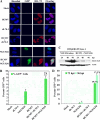Stimulation of homology-directed repair at I-SceI-induced DNA breaks during the permissive life cycle of human cytomegalovirus
- PMID: 21490102
- PMCID: PMC3126324
- DOI: 10.1128/JVI.02514-10
Stimulation of homology-directed repair at I-SceI-induced DNA breaks during the permissive life cycle of human cytomegalovirus
Abstract
Human cytomegalovirus (HCMV) selectively relocalizes many DNA repair proteins, thereby avoiding a potentially detrimental damage response. In the present study, we evaluated interactions between HCMV and the homology-directed repair (HDR) pathway. In permissive human foreskin fibroblasts, a fluorescence-based double-stranded break repair assay was used to determine that HCMV stimulated HDR. Repair of both stably integrated and extrachromosomal reporter substrates was observed to increase. HDR was also stimulated through individual expression of the viral immediate-early protein IE1-72, mimicking full virus infection. These experiments further demonstrate HCMV's role in modulating critical cellular processes during a permissive infection.
Figures




Similar articles
-
Modulation of homology-directed repair in T98G glioblastoma cells due to interactions between wildtype p53, Rad51 and HCMV IE1-72.Viruses. 2014 Feb 26;6(3):968-85. doi: 10.3390/v6030968. Viruses. 2014. PMID: 24576846 Free PMC article.
-
Human cytomegalovirus disrupts both ataxia telangiectasia mutated protein (ATM)- and ATM-Rad3-related kinase-mediated DNA damage responses during lytic infection.J Virol. 2007 Feb;81(4):1934-50. doi: 10.1128/JVI.01670-06. Epub 2006 Dec 6. J Virol. 2007. PMID: 17151099 Free PMC article.
-
An E2F1-mediated DNA damage response contributes to the replication of human cytomegalovirus.PLoS Pathog. 2011 May;7(5):e1001342. doi: 10.1371/journal.ppat.1001342. Epub 2011 May 12. PLoS Pathog. 2011. PMID: 21589897 Free PMC article.
-
Disruption of PML-associated nuclear bodies by IE1 correlates with efficient early stages of viral gene expression and DNA replication in human cytomegalovirus infection.Virology. 2000 Aug 15;274(1):39-55. doi: 10.1006/viro.2000.0448. Virology. 2000. PMID: 10936087
-
The DNA damage response induced by infection with human cytomegalovirus and other viruses.Viruses. 2014 May 23;6(5):2155-85. doi: 10.3390/v6052155. Viruses. 2014. PMID: 24859341 Free PMC article. Review.
Cited by
-
Human Cytomegalovirus Utilizes Multiple Viral Proteins to Regulate the Basement Membrane Protein Nidogen 1.J Virol. 2022 Oct 26;96(20):e0133622. doi: 10.1128/jvi.01336-22. Epub 2022 Oct 11. J Virol. 2022. PMID: 36218358 Free PMC article.
-
DNA damage response(DDR): a link between cellular senescence and human cytomegalovirus.Virol J. 2023 Nov 1;20(1):250. doi: 10.1186/s12985-023-02203-y. Virol J. 2023. PMID: 37915066 Free PMC article. Review.
-
HCMV-infected cells maintain efficient nucleotide excision repair of the viral genome while abrogating repair of the host genome.PLoS Pathog. 2012;8(11):e1003038. doi: 10.1371/journal.ppat.1003038. Epub 2012 Nov 29. PLoS Pathog. 2012. PMID: 23209410 Free PMC article.
-
Modulation of homology-directed repair in T98G glioblastoma cells due to interactions between wildtype p53, Rad51 and HCMV IE1-72.Viruses. 2014 Feb 26;6(3):968-85. doi: 10.3390/v6030968. Viruses. 2014. PMID: 24576846 Free PMC article.
-
Human Cytomegalovirus Interactions with the Basement Membrane Protein Nidogen 1.J Virol. 2021 Jan 13;95(3):e01506-20. doi: 10.1128/JVI.01506-20. Print 2021 Jan 13. J Virol. 2021. PMID: 33177203 Free PMC article.
References
-
- Bennett B. T., Knight K. L. 2005. Cellular localization of human Rad51C and regulation of ubiquitin-mediated proteolysis of Rad51. J. Cell. Biochem. 96:1095–1109 - PubMed
Publication types
MeSH terms
Substances
Grants and funding
LinkOut - more resources
Full Text Sources
Other Literature Sources
Research Materials
Miscellaneous

